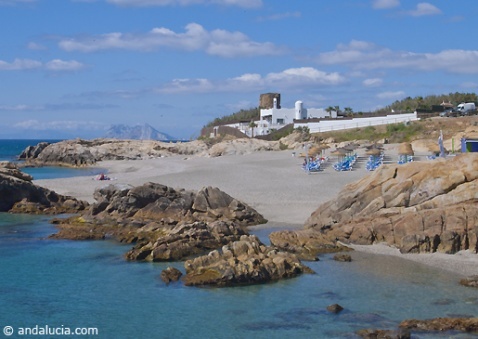
Punta de la Chullera Beach |
|
Manilva Beaches west to east
continued from Sotogrande beaches to the west.
PUNTA DE LA CHULlERA
There is a small, 100m-wide cove hidden by cliffs and rocks each side. Thanks to a good chiringuito it's an ideal getaway in the summer. The beach is fairly crowded during the summer and especially at weekends; parking access is especially difficult. On the A7 heading west at km138, just before the footbridge, is a small access road. Follow this to the left and, off the small turning area at the end, a path leads to the beach.
Historically Punta de la Chulera was an important landmark and there are still two watchtowers. One, 500m inland from the Moorish Nasarid era and the other Punta Chullera watchtower from the 15th century.
PLAYA CHULlERA
This refers to a series of four beaches locally named Playa de las Arenas, Cala Sardina, Playa del Negro, and Playa de los Toros in a straight, flat part of the coast totalling 10km, from Punta de la Chullera in the west to La Duquesa marina in the east. The beaches are generally very quiet. The A7 coast road runs parallel to the beach, one block away, and the spur roads that lead down to the beach offer a number of access points and parking areas. The beach is on average 60m wide, gently sloping and backed by rough heath in some places, with few chiringuitos with sunbeds, as well as showers and lifeguard points. The beach is so expansive that in the areas furthest away from access points, it is very quiet - even on summer weekends. The beach is cleaned in the summer, but to a lesser degree than the urban beaches to the east, resulting in more driftwood and pebbles amongst the sand - like all on the Costa del Sol, this is course and dark-coloured. The flora and fauna on this stretch of coast is a protected as an ecological reserve under law 2003/8.
Playa Las Arenas
Las Arenas beach is also known as Playa Gobernador or Tubalitas and is backed by steeply rising headland where the A7 coast road has a lay-by with a beach bar which afords splendid views of not just the the beach below but right along the coast.
Playa La Cala
Playa La Cala de la Sardina is only 150 m wide and bounded by two rocky piers and backed by an long established development.
Playa del Negro
Playa del Negro has an important dune vegetation.
Playa de Los Toros
Playa de los Toros which runs for 2.4km from the Aroyo Alcorrin was named after the area the cattle were driven from La Cañana Real of Los Barrios to Estepona. It is the most open of the beaches and the least urbanised. The natural dunes vegitation includes 'Hairy Tare'.
PLAYA DEL CASTILLO
Playa del Castillo is named after the ruined fort nearby. A small but interesting fishing hamlet called El Castillo de la Duquesa (or El Castillo for short) with little plazas is located here. The castle is used for occasional municipal exhibitions and a couple of fenced-off adjacent areas hold partially excavated Roman ruins. To the east of Castillo, and surrounded by modern apartment blocks, is the marina Puerto de la Duquesa. The beach runs up to the harbour wall. This beach has chiringuitos with sunbeds, and shower and lifeguard points. The chiringuito nearest Duquesa is called Chiringuito La Gaviotas . The beach is moderately busy, but more crowded towards the Duquesa harbour area at the east. Car parking is usually available in the village streets. The small village has a rock-supported sea wall, so the beaches are either side of the village. Playa de la Chullera is to the west and Playa del Castillo and Playa de las Gaviotas to the east.
PLAYA SABINILLAS
Playa Sabinillas is another extensive straight beach, 2km long and about 40m wide, to the east of Puerto de la Duquesa as far as the Rio Manilva. The west end of the beach is also called Playa de la Colonia after the summer school of the same name. Playa Sabinillas is now supported by a new seafront promenade for most of its length and a new apartment block, making it an urban beach. This busy beach has chiringuitos with sunbeds, along with showers and lifeguard watchtowers and points. Behind the promenade are many bars, restaurants, corner stores and kiosks. The beach is frequented by the local residents of Manilva and San Luis de Sabinillas (known as Sabinillas) - you'll find very few hotels or international tourists on this part of the coast. Sabinillas is the original fishing hamlet for the village of Manilva. Whilst very few fishing boats are pulled up on the beach these days, the original fisherman's cottages can still be seen. This beach is well cleaned in the summer, while car parking is usually available in the village streets. This beach has been awarded a Blue Flag by the European Union for its high standards of cleanliness and excellent facilities.
Continue to next beach to the eastPlaya Ancha, Casares